Setup Guide for Guided Tutorials in Artemis
This guide gives you instructions on how to setup and create guided tutorials for Artemis:
Create GuidedTour object
A guided tutorial can be created by instantiating a GuidedTour object.
This object has the mandatory attributes settingsKey, the identifier for the tutorial which will be stored in the
database, and steps, which is an array that stores all tutorial steps.
A tutorial can have different types of tutorial steps:
TextTourStep: tutorial step with only text contentImageTourStep: tutorial step with text content and embedded imageVideoTourStep: tutorial step with text content and embedded videoUserInteractionTourStep: tutorial step which requires a certain interaction from the user to proceed to the next step.ModelingTaskTourStep: tutorial step with text content and modeling task for the Apollon editor that is assessed for the stepAssessmentTaskTourStep: tutorial step with text content and a tutor assessment task for example submissions (currently only implemented for text assessments).
TextTourStep with highlighted element
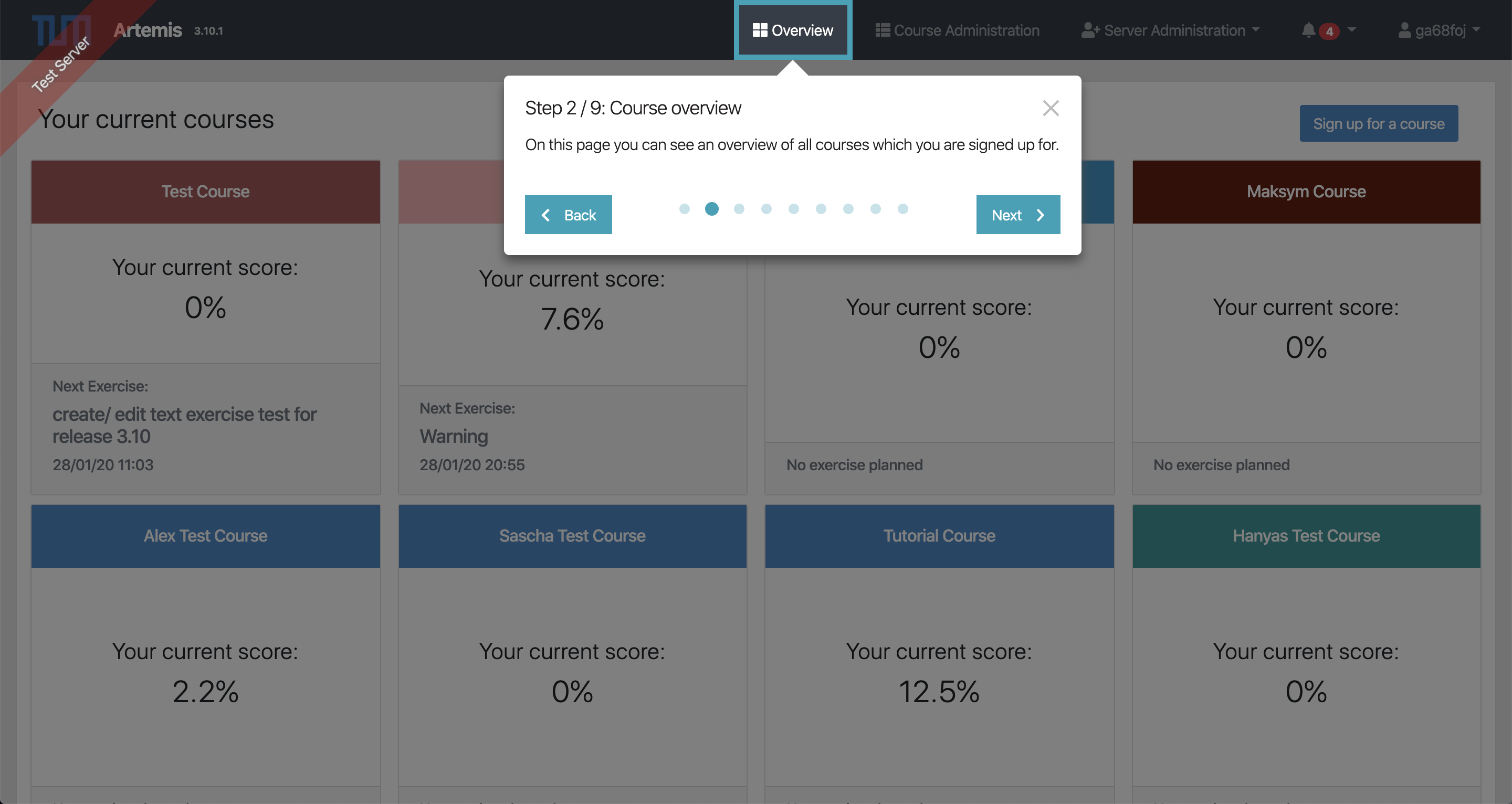
TextTourStep with highlighted element
TextTourStep with multiple markdown elements

TextTourStep with multiple markdown elements
ImageTourStep
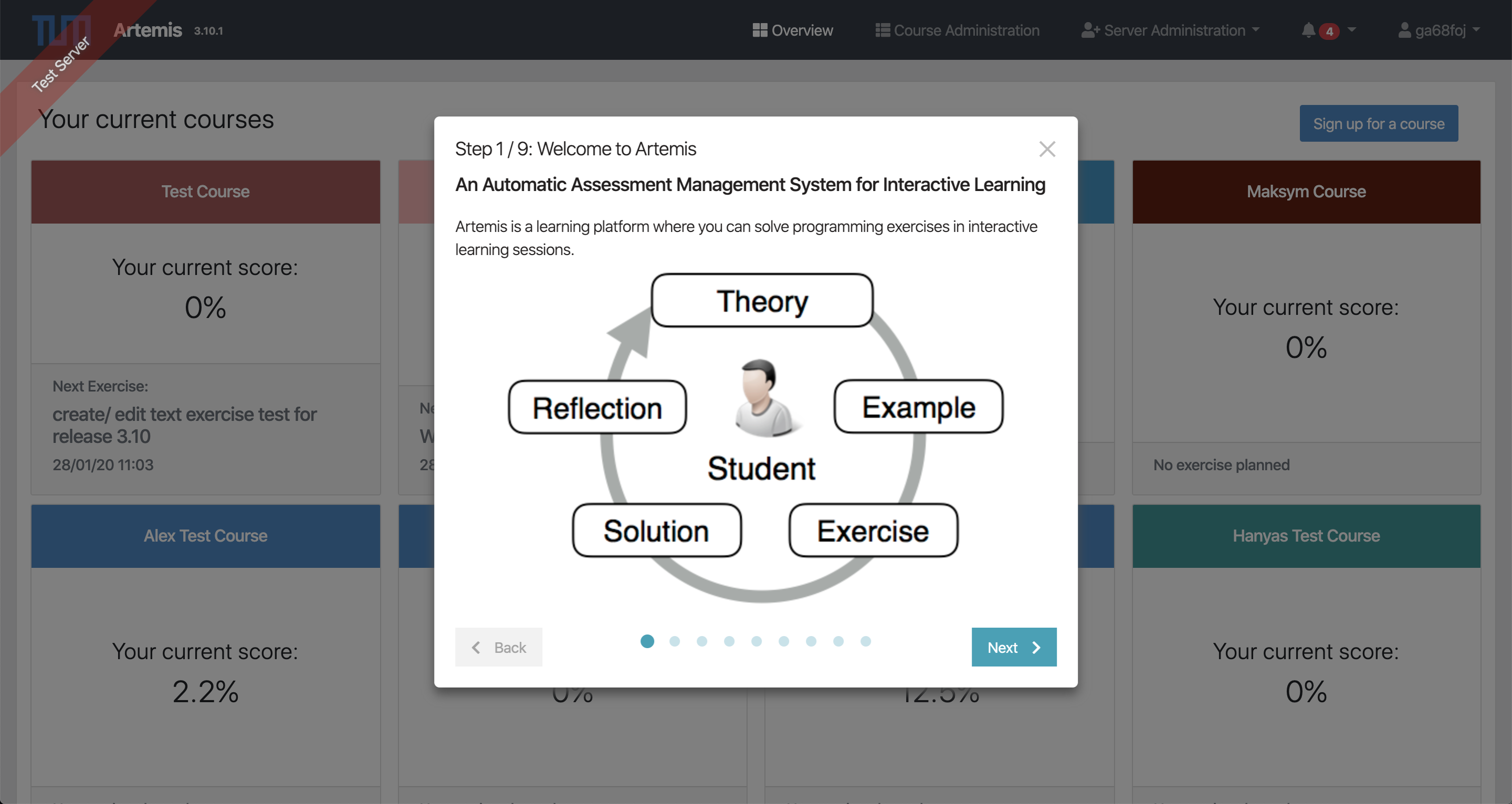
ImageTourStep
VideoTourStep

VideoTourStep
UserInteractionTourStep
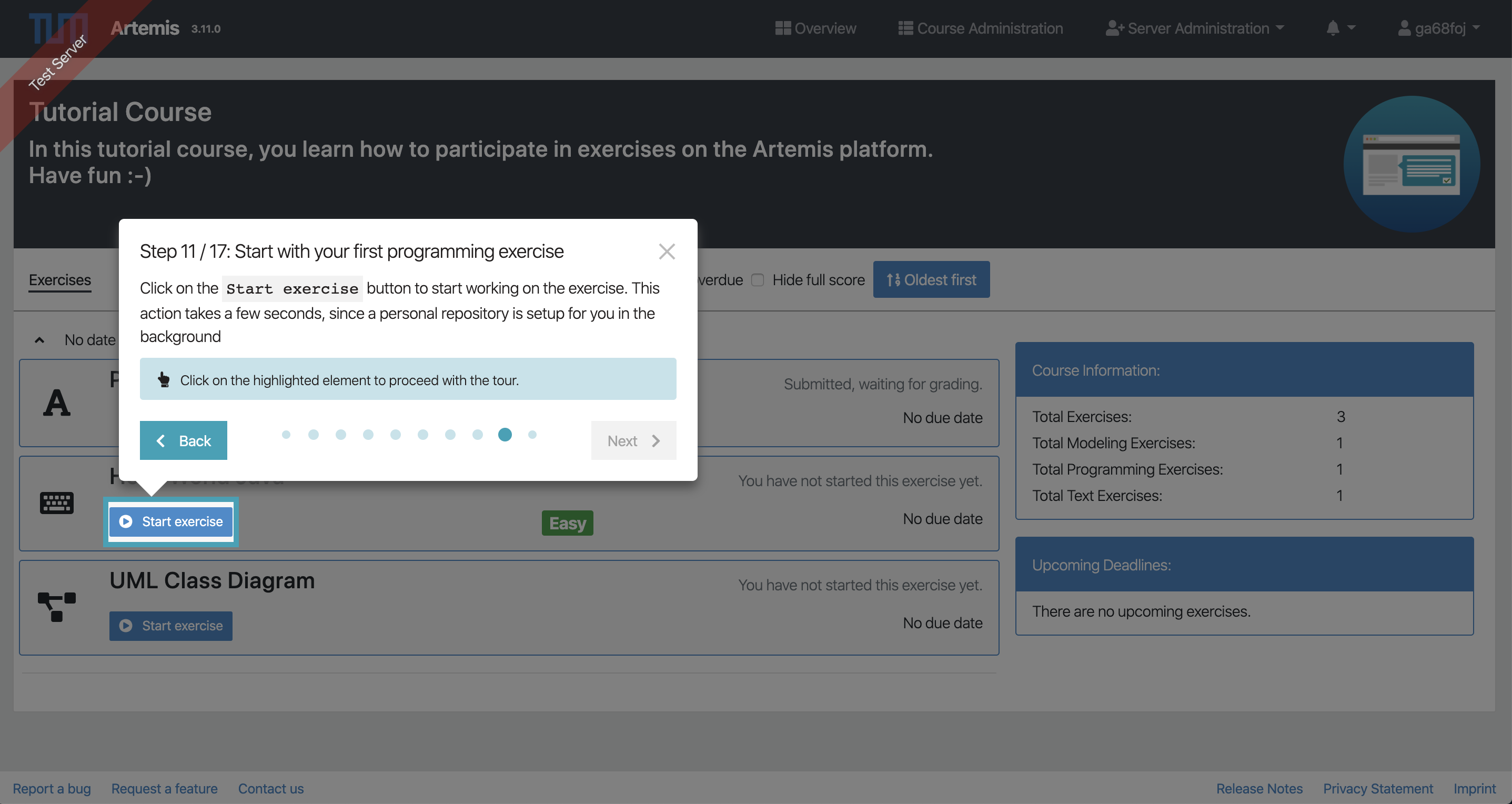
UserInteractionTourStep
ModelingTaskTourStep
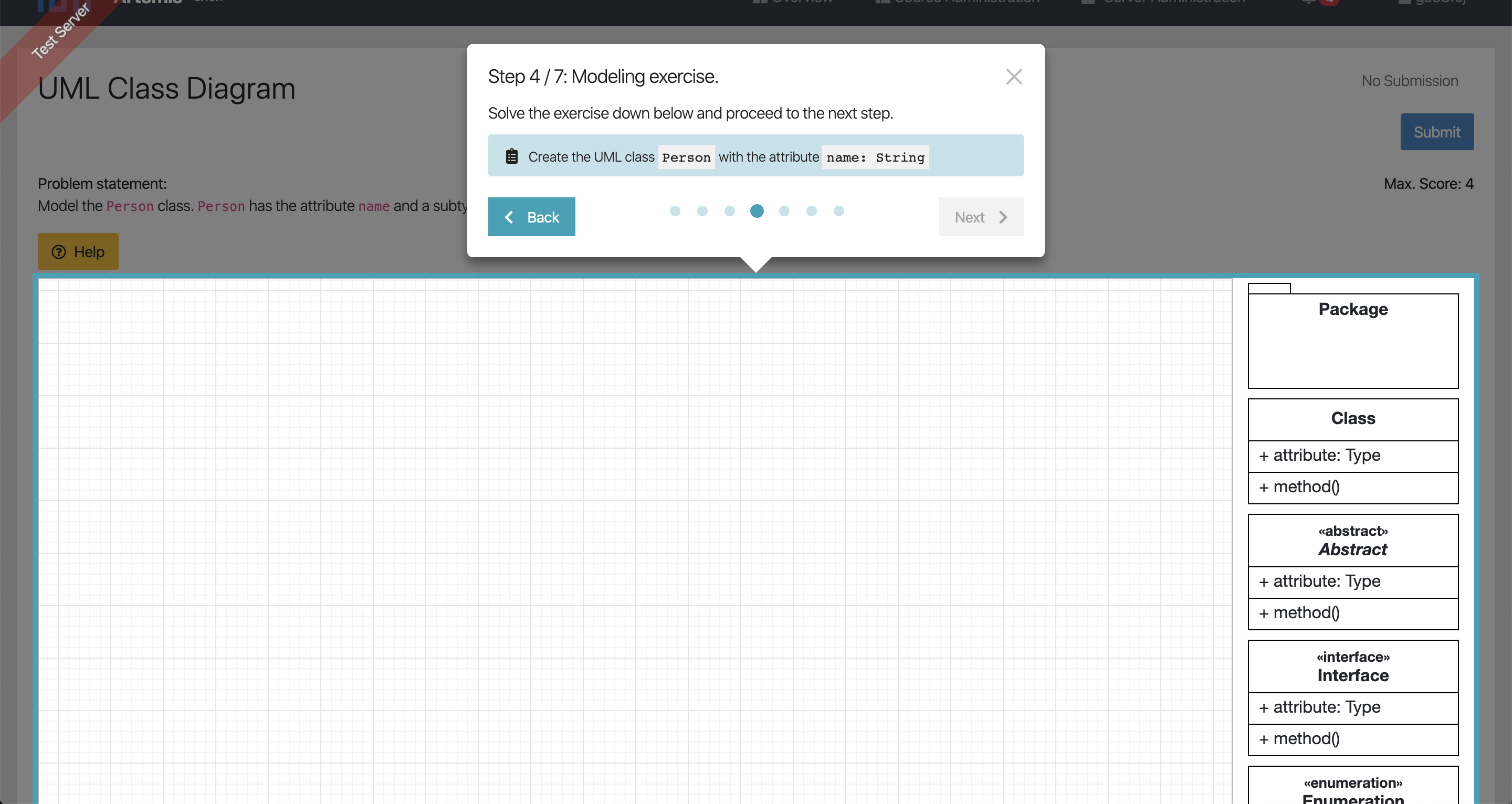
ModelingTaskTourStep
AssessmentTaskTourStep
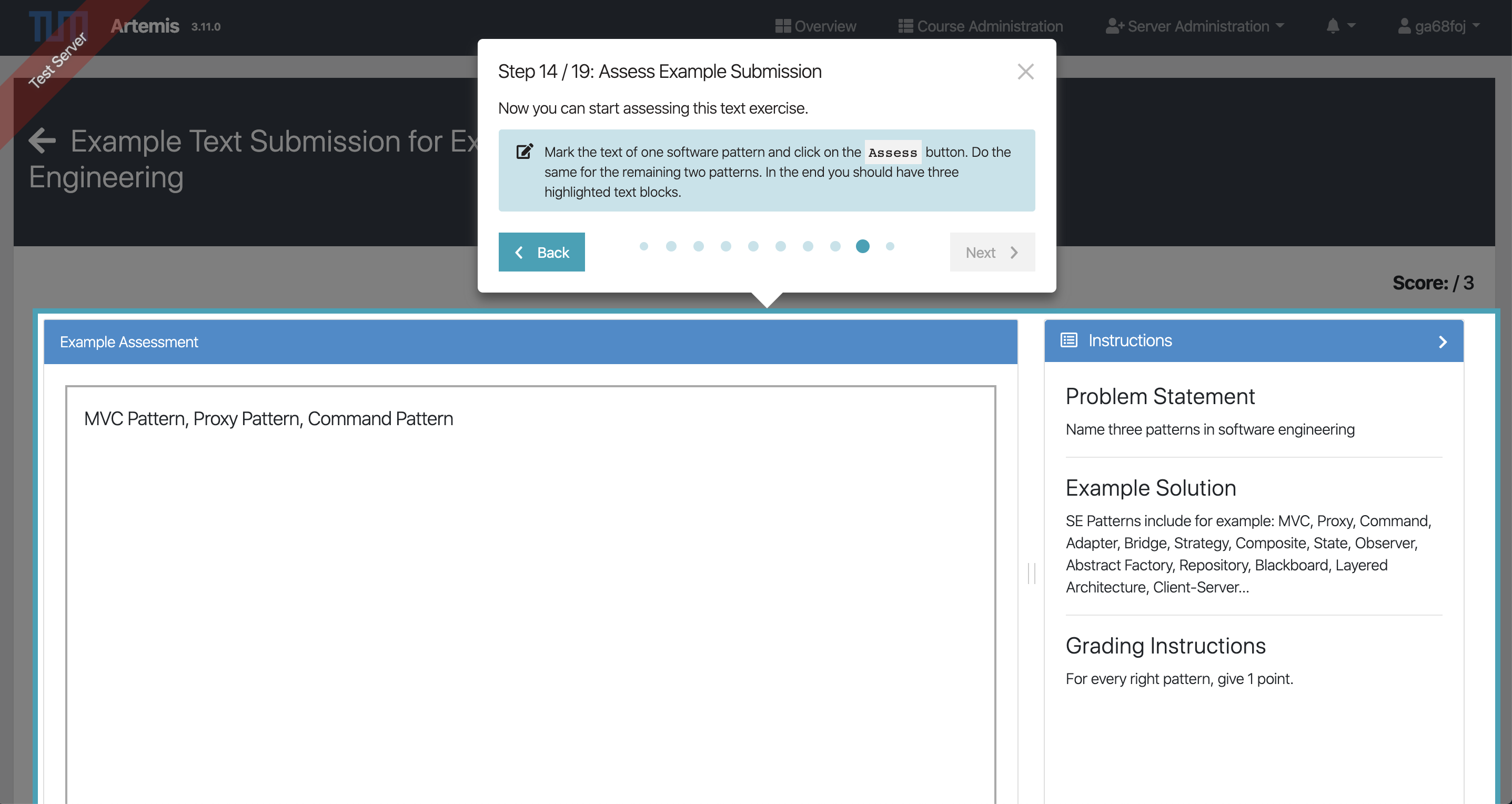
AssessmentTaskTourStep
Example implementation of a GuidedTour object
In this example, the GuidedTour object is created and assigned to the constant exampleTutorial,
which one can use to embed the tutorial to a component of choice.
1import { Orientation, UserInteractionEvent } from '../../src/main/webapp/app/guided-tour/guided-tour.constants';
2import { GuidedTour } from '../../src/main/webapp/app/guided-tour/guided-tour.model';
3import { ImageTourStep, ModelingTaskTourStep, TextTourStep, VideoTourStep } from '../../src/main/webapp/app/guided-tour/guided-tour-step.model';
4import { GuidedTourModelingTask, personUML } from '../../src/main/webapp/app/guided-tour/guided-tour-task.model';
5
6export const exampleTutorial: GuidedTour = {
7 settingsKey: 'example_tutorial',
8 steps: [
9 new TextTourStep({
10 highlightSelector: '.guided-tour-overview',
11 headlineTranslateKey: 'tour.courseOverview.overviewMenu.headline',
12 contentTranslateKey: 'tour.courseOverview.overviewMenu.content',
13 highlightPadding: 10,
14 orientation: Orientation.BOTTOM,
15 }),
16 new ImageTourStep({
17 headlineTranslateKey: 'tour.courseOverview.welcome.headline',
18 subHeadlineTranslateKey: 'tour.courseOverview.welcome.subHeadline',
19 contentTranslateKey: 'tour.courseOverview.welcome.content',
20 imageUrl: 'https://ase.in.tum.de/lehrstuhl_1/images/teaching/interactive/InteractiveLearning.png',
21 }),
22 new VideoTourStep({
23 headlineTranslateKey: 'tour.courseExerciseOverview.installPrerequisites.sourceTreeSetup.headline',
24 contentTranslateKey: 'tour.courseExerciseOverview.installPrerequisites.sourceTreeSetup.content',
25 hintTranslateKey: 'tour.courseExerciseOverview.installPrerequisites.sourceTreeSetup.hint',
26 videoUrl: 'tour.courseExerciseOverview.installPrerequisites.sourceTreeSetup.videoUrl',
27 }),
28 new ModelingTaskTourStep({
29 highlightSelector: 'jhi-modeling-editor .guided-tour.modeling-editor .modeling-editor',
30 headlineTranslateKey: 'tour.modelingExercise.executeTasks.headline',
31 contentTranslateKey: 'tour.modelingExercise.executeTasks.content',
32 highlightPadding: 5,
33 orientation: Orientation.TOP,
34 userInteractionEvent: UserInteractionEvent.MODELING,
35 modelingTask: new GuidedTourModelingTask(personUML.name, 'tour.modelingExercise.executeTasks.personClass'),
36 }),
37 // ...
38 ],
39};
Mandatory attributes
TextTourStep: The mandatory fields areheadlineTranslateKeyandcontentTranslateKey.ImageTourStep: The ImageTourStep extends the TextTourStep and hasimageUrlas an additional mandatory attribute.VideoTourStep: The VideoTourStep extends the TextTourStep and hasvideoUrlas an additional mandatory attribute.UserInterActionTourStep: The UserInterActionTourStep extends the TextTourStep and is used to include interactions tasks for the user during the tour step. It has the additional mandatory attributeuserInteractionEvent, which defines the interaction type, and the optional attributetriggerNextStep.ModelingTaskTourStep: The ModelingTaskTourStep extends the UserInterActionTourStep and hasmodelingTaskas an additional mandatory attribute.AssessmentTaskTourStep: The AssessmentTaskTourStep extends the UserInterActionTourStep and hasassessmentTaskas an additional mandatory attribute.
Optional attributes
There are many optional attributes that can be defined for a tour step. These attributes and their definition
can be found in the abstract class TourStep.
Below, you can find a list of attributes that are used more often:
highlightSelector: For thehighlightSelectoryou have to enter a CSS selector for the HTML element that you want to highlight for this step. For better maintainability of the guided tutorials, it is strongly advised to create new selectors with the prefixguided-tourwithin the DOM and use it as the highlight selector.orientation: We can define an orientation for every tour step individually. The tour step orientation is used to define the position of the tour step next to highlighted element.highlightPadding: This attribute sets the additional padding around the highlight element.userInteractionEvent: Some steps require user interactions, e.g. certain click events, before the next tour step can be enabled. The supported user interactions are defined in the enumUserInteractionEvent.pageUrl: If you want to create a multi-page tutorial, i.e. a tutorial that guides the user through multiple component pages, then you have to use this attribute. ThepageUrlshould be added to the first tutorial step of every page and if the URL has identifiers in the URL such as course or exercise ids then these numbers should be replaced with the regex(\d+)+. An example of multi-page tutorials can be found in thetutor-assessment-tour.tsfile.
Add translations
In order to allow internationalization, the values for the attributes headlineTranslateKey,
subHeadlineTranslateKey, contentTranslateKey and hintTranslateKey reference the text snippets
which are stored in JSON translation document.
Further attributes that need translations are videoUrl for VideoTourStep and taskTranslateKey
for the modelingTask in the ModelingTaskTourStep.
One JSON document that is used for the translations of guided tutorials is the file guidedTour.json.
Embed in component file
There are multiple service methods to embed a guided tutorial in an application component file. We use the GuidedTutorialService in the component through dependency injection and invoke the fitting method to enable the tutorial for the component:
The enableTourForCourseOverview method is used when the tutorial should be enabled for a certain course in
a component, which displays a list of courses (e.g. overview.component.ts).
It returns the course for which the tutorial is enabled, if available, otherwise null.
public enableTourForCourseOverview(courses: Course[], guidedTour: GuidedTour, init: boolean): Course | null {
The enableTourForCourseExerciseComponent method is used when the tutorial should be enabled for a certain course
and exercise in a component, which displays a list of exercises for a course (e.g. course-exercises.component.ts).
It returns the exercise for which the tutorial is enabled, if available, otherwise null.
public enableTourForCourseExerciseComponent(course: Course | null, guidedTour: GuidedTour, init: boolean): Exercise | null {
The enableTourForExercise method is used when the tutorial should be enabled for a certain exercise
(e.g. course-exercise-details.component.ts).
It returns the exercise for which the tutorial is enabled, if available, otherwise null.
public enableTourForExercise(exercise: Exercise, guidedTour: GuidedTour, init: boolean) {
Example of integrating the GuidedTour exampleTutorial into a component file
constructor( private guidedTourService: GuidedTourService ) {}
...
this.courseForGuidedTour = this.guidedTourService.enableTourForCourseOverview(this.courses, exampleTutorial, true);
Extend configuration file
The mapping of guided tutorials to certain courses and exercises is configured in the application-dev.yml and
application-prod.yml files.
The yaml configuration below shows that the guided tutorials are only enabled for the course with the short name
artemistutorial.
The configuration for tours shows a list of mappings tutorialSettingsKey → exerciseIdentifier.
The exerciseIdentifier for programming exercises is the exercise short name, otherwise it’s the exercise title.
The optional course-group-students property is used to automatically add the given tutorial’s course group to
all the new created users.
This functionality can be extended to users with instructor or teaching assistant roles, adding the optional
course-group-instructors and/or course-group-tutors properties.
In this case, newly created users with instructor or teaching assistant roles will be assigned to their
respectively tutorial’s course groups.
info:
guided-tour:
course-group-students: 'artemis-artemistutorial-students'
courseShortName: 'artemistutorial'
tours:
- cancel_tour: ''
- code_editor_tour: 'tutorial'
- course_overview_tour: ''
- course_exercise_overview_tour: 'tutorial'
- modeling_tour: 'UML Class Diagram'
- programming_exercise_fail_tour: 'tutorial'
- programming_exercise_success_tour: 'tutorial'
- tutor_assessment_tour: 'Patterns in Software Engineering'
Writing test cases for guided tutorials
Through Jest client tests it is possible to start the guided tutorials and go through all the tutorial steps while
checking for the highlight selectors.
An example test suite for the courseOverviewTour can be found in the overview.component.spec.ts file.